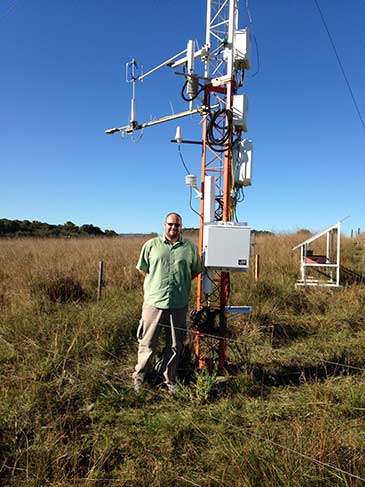Soil moisture plays a major role in the environment/climate system because the transport of water within the land and at the land-atmosphere interface is strongly dependent on the state of soil water in a region.
Despite its importance, lack of soil moisture measurements at various spatial scales has limited our understanding of how individual physical factors control soil moisture dynamics.
AMUSED (A MUlti-scale Soil moisture-Evapotranspiration Dynamics study) is a project that will monitor soil moisture using cosmic-rays sensors in combination with land surface modeling, satellite remote sensing, model diagnostics and data assimilation methods.

Rafael Rosolem with the cosmic-ray soil moisture sensor installed at the the Federal University of Santa Maria SulFlux site in Brazil. Credit: University of Bristol
The project seeks to identify whether a unified science of land-atmosphere interactions across multiple-scales can be achieved. It aims to evaluate the uncertainties of multiple sources of soil moisture observations; identify key processes that control soil moisture dynamics in land surface models; and provide high-quality soil moisture estimates at hyper-resolution. Ultimately, the project will enhance the representation of soil moisture and surface processes in numerical weather prediction and climate models in the UK.
A key component of the project is the use of new cosmic-ray sensors that can measure soil moisture at an unprecedented sub-kilometer scale. This technology has revolutionized the field of hydrometeorology because it provides an opportunity to fill the gap between soil moisture observations from traditional point-scale sensors and large-scale estimates from satellite remote sensing products.
The project will also foster critical and significant training to high-skilled personnel on the use of this new innovative cosmic-ray soil moisture technique in the UK. Principal Investigator Dr. Rafael Rosolem of the Department of Civil Engineering at the University of Bristol was part of the US COsmic-ray Soil Moisture Observing System team (COSMOS) where he worked directly on the network design and deployment of these cosmic-ray sensors across the USA.
The project has a strong collaborative effort with the Centre for Ecology and Hydrology (CEH), as part of the COSMOS-UK initiative, a national network of cosmic-ray neutron sensors to monitor soil moisture at near real-time in the UK. Source: University of Bristol.


